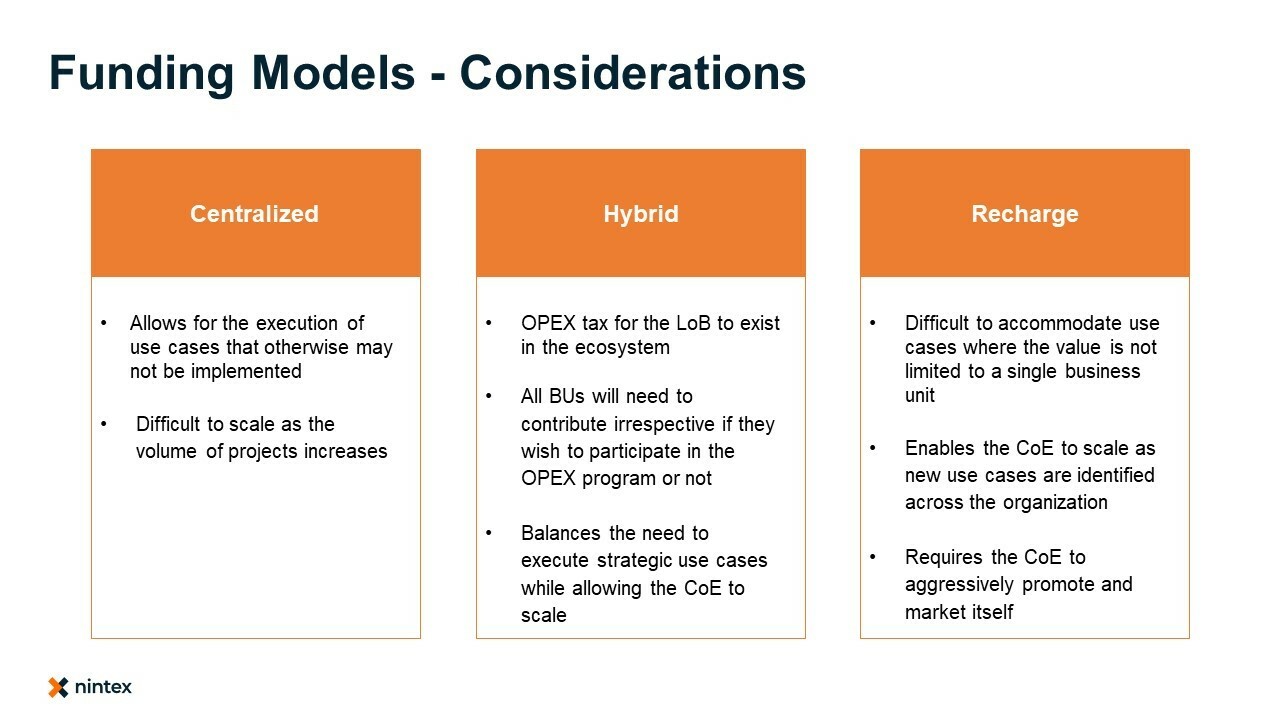If you’ve got this far in our Blog series, it’s safe to assume that you see the value that a Center of Excellence (CoE) could bring to your organization. Establishing and running a CoE however is not free, so in this post I’m going to explore the different approaches that you can take to funding your CoE.
To begin, let’s consider the costs that are involved in establishing and running a CoE. Your fixed costs are the expenses that your CoE will incur even if it doesn’t deliver any use cases, such as the salaries and on-costs of staff, the materials that are used (from stationery to office space), as well as any shared infrastructure. There also may be some licensing costs that you consider a fixed cost – Promapp for example is often considered a fixed cost as it is typically procured and then opened to the business for general use. Your variable costs in contrast are the costs that you incur to deliver specific use cases and will often involve licensing (for example delivering a use case might require one Nintex Workflow licenses and 12 Nintex Sign licenses) as well as consultant’s fees if they are used.
In order to cover these costs, we see three funding models that you can select from:
Centralized
Under a centralized model, the CoE will receive a budget (generally from the office of the CIO or COO) to cover all fixed and variable costs. Along with the budget, the CoE will also be given an ROI target that it is expected to deliver.
Recharge
Under a recharge model the CoE won’t be given any budget, rather will charge the Line of Business (LoB) for the delivery of use cases with the expectation that it is able to be self-sustaining by covering its own costs.
Hybrid
Under a hybrid model, the CoE will be given some budget and then will have to recharge the LoB to make up the difference.
As you might imagine, all three models come with their own pros and cons.

It’s important to remember that use cases typically have spill-over effects such that, while a given use case will often directly improve one team’s process, it will also indirectly improve other team's processes. A Recharge model can create issues in such circumstances as, when asked to pay for the creation of the use case, the primary team may not see enough value to justify the spend resulting in it not getting built.
If instead a Centralized model is used, the CoE can assess the ROI from the perspective of the entire business, not an individual team, which might present a much more compelling business case. A Centralized model does of course have its own challenges, primarily around scale – if the CoE is in hot demand and needs to double in size in order to manage the workload, it could be difficult for the Executive Sponsor to secure that level of funding in a short period of time, even if doing so would deliver huge ROI. This then is where a Recharge Model is valuable as, if each department pays for its own use cases, by tapping into multiple team's budgets then finding the money to add resources to the CoE can be easier and quicker.
A Hybrid approach then seeks to find the best of both worlds. By having some budget at its disposal, the CoE will have the ability to identify and build strategic use cases at its own discretion while being able to scale quickly and efficiently by recharging the LoB for other use cases. This approach is often seen as an ‘Operational Excellence (OPEX) Tax’ as all teams will need to contribute even if they don’t choose to be directly involved; therefore, for this approach to work, your Executive Sponsor will need to ensure that they are selling the benefits of OPEX and the CoE so that all budget holders understand the value of existing in the ecosystem.
Clearly then there is no one best choice – each business will need to weigh up the pros and cons and decide which model is most appropriate based on their situation. This discussion might have also highlighted the fact that, given the costs involved in setting up and running a CoE, even if a CoE could bring value to your organization it may not be the most appropriate use of your resources. As such our next blog post will seek to help you answer the question Is a CoE right for me?.


